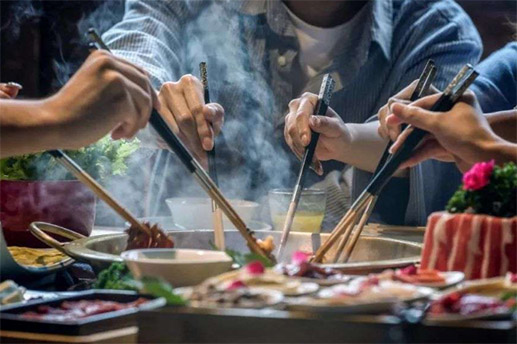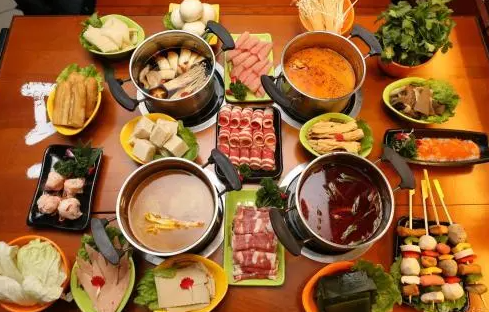2023-09-08
The diversity of Chinese tastes is unparalleled in the world.
The generalization that southern cuisine is sweet, northern cuisine is salty, eastern cuisine is spicy, and western cuisine is sour only scratches the surface.

For instance, even among those who enjoy spicy food, people from Jiangxi emphasize freshness in spiciness, Hunan locals focus on fragrant spiciness, residents of Yunnan and Guizhou favor sour and spicy flavors, and Sichuan and Chongqing residents add a numbing sensation to their dishes.
However, despite these regional preferences, there's one thing that unites Chinese gastronomic aesthetics - hotpot.
When friends gather for a meal nowadays, the number one choice is always a table filled with bubbling hotpot.
Meanwhile, the eight major regional Chinese cuisines, the most representative of Chinese cuisine, seem to have been relegated to the background.
Is this shift due to a decline in traditional Chinese restaurants, or is it because of our changing tastes?
Hotpot: The Contemporary Dining Choice
Whether it's called shuan guo, nuan guo, or dabianlu (various regional names for hotpot), it remains a beloved dish throughout China. Regardless of its name or location, this cuisine is universally popular and continues to gain even more affection.
Data from "China Catering Big Data 2021" revealed that in 2020, the most searched keyword for dining out was 'hotpot,' with an 11.6% increase compared to the previous year.
In fact, the most famous hotpot chain, 'Haidilao,' ranks among the top three in terms of search volume."
Apart from hotpot, other popular dining-related keywords in recent years include barbecue and grilled meats. Many people have started considering these options when choosing a place to dine out. One involves cooking by simmering, while the other involves grilling.
The common denominator among these highly ranked dining categories is their freedom - diners get to cook their own food, season it to their liking, and enjoy the flavors they desire.
In contrast, it's challenging to find traces of Chinese stir-fry cuisine in the top dining-related search terms. However, this doesn't necessarily mean there are fewer Chinese stir-fry restaurants.
In fact, when looking at the distribution of dining establishments nationwide, aside from the predominant fast food and beverage outlets, Chinese stir-fry restaurants maintain a significant presence. They are just further categorized into different regional cuisines, such as Sichuan cuisine, Cantonese cuisine, and Northeastern cuisine.

However, today, apart from Sichuan cuisine which still remains popular, there hasn't been a significant increase in the proportion of other regional Chinese cuisines. Cuisines like Hunan cuisine and Xinjiang cuisine, which are considered common in commercial areas, are actually rare in other provinces.
In the past year, the number of hotpot and barbecue establishments has continued to grow. According to the Meituan Research Institute's "2020 Semi-Annual Meituan Late-Night Snack Index Development Report," during dinner and late-night dining hours, regardless of the geographical region, about half of the diners choose hotpot as their meal of choice, by barbecue.
People from all over the country seem to have reached a consensus when it comes to what to eat when dining together.
Gathering for hotpot has become popular because it's genuinely simple.
Diners love hotpot, and restaurant owners are delighted about this trend.
After all, compared to other types of restaurants, hotpot establishments require much less effort. Let's first mention the typical cost structure of opening a restaurant: the use and wastage of raw materials, staff costs including meals and accommodation, and expenses related to location selection, decoration, rent, and operations. Among these, the cost of raw materials for cooking and the labor cost for preparing and serving food have the highest proportion.
However, controlling these costs is not as straightforward in traditional Chinese restaurants.
In general, Chinese stir-fry cuisine relies heavily on the skills of the chefs. The staffing in a complete kitchen can be further divided into many specialized roles, building upon both "hong an" (Chinese culinary) and "bai an" (pastry and dim sum making). However, due to the long training period for chefs, unfavorable working conditions, and the lack of significant advantages in terms of compensation, the market for such talent has long been in a state of high demand and short supply.
Since the Ministry of Human Resources and Social Security began publishing a ranking of occupations in short supply in 2019, the profession of Chinese culinary chef has consistently made the list. Moreover, it's not just stir-fry chefs; even restaurants looking for skilled chefs to prepare dishes that require special techniques, such as noodle-pulling, often face fierce competition to secure such talent.
This is where the advantages of hotpot and barbecue restaurants become evident: the handling of ingredients and seasonings is simpler, and the skill requirements for chefs are noticeably lower. When the ingredients for hotpot or barbecue only require washing, marinating, and plating, creating an exquisite Chinese dish involves more steps and ingredient complexity.
Surveys of the operational efficiency in different types of dining establishments confirm that hotpot indeed offers a higher net profit margin. Furthermore, compared to regular meals, hotpot not only has a higher table turnover rate and higher average per capita spending but also incurs lower managerial staff wages.
Compared to stir-frying, the flavor of hotpot is much more consistent. The simple cooking method for ingredients not only reduces labor costs but also makes it easier to franchise hotpot and barbecue establishments compared to restaurants that heavily rely on chefs' culinary skills, such as Chinese stir-fry or Western cuisine.
Achieving standardization in stir-frying is indeed challenging. In addition to standardizing ingredients and seasonings, the cutting techniques and cooking timing can significantly impact the taste of dishes. Even within the same Chinese restaurant brand, visiting on different days may result in varying flavors.
For example, Songhelou is a well-established restaurant in Suzhou that also has branches in Beijing. Many people who have dined at the Jiangsu and Zhejiang locations were somewhat disappointed with the Beijing branch. For their signature dish, Squirrel-shaped Mandarin Fish, some reviews on a popular dining platform mentioned: "A bit fishy," "Quite fishy," "Didn't get the sweet and sour balance right," "The skin started to peel as soon as it was served!"
In contrast, hotpot and barbecue, which focus on the quality of ingredients, have the advantage of standardization - using the same broth, sauces, and ingredients, combined with straightforward cooking methods, makes it easier to maintain consistent flavors.
As a result, many top-tier restaurants have started establishing central kitchens to strengthen ingredient quality control. Some even send semi-finished or finished products directly to their branch locations. This allows branch locations to focus on service while not worrying about fluctuations in the taste of the dishes.
As a result of these standardization strategies, there has been a growing trend toward franchise chains, not only in hotpot and barbecue but in almost all dining categories.
Additionally, there's another unique advantage that hotpot offers over stir-frying – it allows for a leisurely dining experience.
For example, when three to five friends gather for a meal, if they opt for stir-fried dishes, they might feel full after six or seven dishes. If the restaurant serves the dishes quickly, the meal could be finished in less than half an hour. Moreover, they can't eat too slowly, or else the dishes will get cold. Hotpot, on the other hand, provides a different experience.
When ingredients are placed in the broth, diners may need to wait a bit after eating a few bites. The cooking process takes time, but it creates an ideal opportunity for the entire table to engage in conversation.
A survey conducted among university students in major Chinese cities (Beijing, Shanghai, Guangzhou, and Shenzhen) confirms this preference. Young people tend to favor hotpot over traditional Chinese meals because it's conducive to socializing and offers a way to relieve stress.
Cenhot is a professional supplier for hot pot equipment and Korean BBQ equipment.
You could find the equipment as below